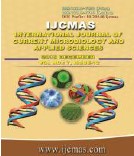


 National Academy of Agricultural Sciences (NAAS)
National Academy of Agricultural Sciences (NAAS)

|
PRINT ISSN : 2319-7692
Online ISSN : 2319-7706 Issues : 12 per year Publisher : Excellent Publishers Email : editorijcmas@gmail.com / submit@ijcmas.com Editor-in-chief: Dr.M.Prakash Index Copernicus ICV 2018: 95.39 NAAS RATING 2020: 5.38 |
Salinity in soil or water is one of the major stresses and especially in arid and semi-arid regions, can severely limit crop production. Chickpea (Cicer arietinum L.)is sensitive to salinity that affects its yield and there is need to identify the tolerant genotypes. In order to evaluate the effect of soil salinity, a pot experiment with two chickpea genotypes was carried out under screen house conditions. The required amounts of chloride and sulphate salts of Na+, Ca+2 and Mg+2 were added through NaCl, Na2SO4, CaCl2, MgCl2 and MgSO4. Sodium and Ca+2 + Mg+2 were in the ratio of 1:1 where Ca+2 and Mg+2 were in the ratio of 1:3 to develop three (2.0, 4.0, 6.0 dS m-1) levels of saline soil before sowing. The control plants were irrigated with distilled water. Sampling was done at 50-60 days after sowing. The hydrogen peroxide of leaves and roots and lipid peroxidation (MDA) of leaves and roots increased significantly in both the genotypes under different salinity levels. The H2O2 content increased significantly by 0.380 to 0.625 and 0.366 to 0.579 (moles g-1DW) x 10-4 in leaves at 50-60 DAS in the genotypes CSG-8962 and HC-3, respectively with increasing the level of salinity. In roots, at 50-60 DAS, H2O2 content increased significantly from 0.260 to 0.470 in the genotype CSG-8962 and 0.217 to 0.401 (moles g-1DW x 10-4) in the HC-3, with increase in salinity levels from control to 6.0 dS m-1. In leaves, at 50-60 DAS, a significant accumulation of MDA content was observed in both the genotypes under salinity levels. This increase was from 13.40 to 21.43 n moles g-1 dry weight in the genotypes CSG-8962 and 13.38 to 17.43 in HC-3 with increasing levels of salinity from control to 6.0 dS m-1. In roots, an increase from 10.35 to 16.59 n moles g-1dry weight in MDA content was observed in the genotype CSG-8962, however, in HC-3, this was from 10.55 to 13.83 with increasing levels of salinity from control to 6.0 dS m-1 at 50-60 DAS. The specific activities of ROS scavenging enzymes such as SOD, CAT, POX, APX, GPX, GR and GST increased in leaves of both the chickpea genotypes, upon increasing levels of salinity from control to 6.0 dS m-1 at 50-60 DAS. The increase was more in HC-3 as compared to CSG-8962. Despite the increase in the activity of these enzymes, AsA content decreased 42.3 and 36.1 % in the leaves of CSG-8962 and HC-3, respectively. Higher activities of antioxidant enzymes, lower accumulation H2O2, MDA and AsA content in HC-3 than in CSG-8962 indicated that these enzymes play a key role in removal of ROS better in HC-3 than CSG-8962, thus minimizing the cellular damage caused by ROS under salinity levels. The yield parameters like number of branches plant-1, number of pods plant-1, number of seeds plant-1, 100 seed weight and seed yield plant-1 decreased more in CSG-8962 than HC-3 with increasing salinity levels from control to 6.0 dS m-1. The reduction is more in CSG-8962 as compared to HC-3. Hence, the mechanism of salt tolerance is relatively better in HC-3 than in CSG-8962 as found from physiological and yield attributes studied and could be used in crop improvement programme of chickpea for salinity tolerance.
 |
 |
 |
 |
 |